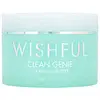What's inside
What's inside
 Key Ingredients
Key Ingredients

 Benefits
Benefits

 Concerns
Concerns

 Ingredients Side-by-side
Ingredients Side-by-side

Water
Skin ConditioningSodium Cocoyl Glycinate
CleansingSodium Cocoamphoacetate
CleansingCocamidopropyl Betaine
CleansingSodium Chloride
MaskingPolyglyceryl-10 Laurate
Skin ConditioningGlycerin
HumectantAcrylates/C10-30 Alkyl Acrylate Crosspolymer
Emulsion StabilisingGlycol Distearate
EmollientSucrose
HumectantMalpighia Punicifolia Fruit Extract
AntioxidantChaenomeles Sinensis Fruit Extract
AntioxidantCamellia Sinensis Leaf Extract
AntimicrobialFicus Carica Fruit Extract
HumectantGinkgo Biloba Leaf Extract
Skin ConditioningTocopheryl Acetate
AntioxidantCoconut Acid
CleansingSodium Cocoate
CleansingSodium Metabisulfite
AntioxidantPolyquaternium-7
Sodium Benzotriazolyl Butylphenol Sulfonate
UV AbsorberButylene Glycol
HumectantCaprylyl Glycol
EmollientSodium Benzoate
MaskingPhenoxyethanol
PreservativeParfum
MaskingBenzyl Salicylate
PerfumingCI 42090
Cosmetic ColorantCI 16035
Cosmetic ColorantCI 77891
Cosmetic ColorantCI 19140
Cosmetic ColorantCI 15985
Cosmetic ColorantWater, Sodium Cocoyl Glycinate, Sodium Cocoamphoacetate, Cocamidopropyl Betaine, Sodium Chloride, Polyglyceryl-10 Laurate, Glycerin, Acrylates/C10-30 Alkyl Acrylate Crosspolymer, Glycol Distearate, Sucrose, Malpighia Punicifolia Fruit Extract, Chaenomeles Sinensis Fruit Extract, Camellia Sinensis Leaf Extract, Ficus Carica Fruit Extract, Ginkgo Biloba Leaf Extract, Tocopheryl Acetate, Coconut Acid, Sodium Cocoate, Sodium Metabisulfite, Polyquaternium-7, Sodium Benzotriazolyl Butylphenol Sulfonate, Butylene Glycol, Caprylyl Glycol, Sodium Benzoate, Phenoxyethanol, Parfum, Benzyl Salicylate, CI 42090, CI 16035, CI 77891, CI 19140, CI 15985
Caprylic/Capric Triglyceride
MaskingEthylhexyl Palmitate
EmollientPEG-20
HumectantPEG-20 Glyceryl Triisostearate
EmollientPEG-5 Glyceryl Triisostearate
EmollientPolyethylene
AbrasiveCamellia Sinensis Leaf Extract
AntimicrobialMalachite Extract
AntioxidantPrunus Yedoensis Leaf Extract
Skin ConditioningPrunus Lannesiana Flower Extract
Skin ConditioningPrunus Serrulata Flower Extract
Skin ConditioningAscorbic Acid
AntioxidantMalic Acid
BufferingTocopherol
AntioxidantTriethoxycaprylylsilane
Aluminum Hydroxide
EmollientWater
Skin ConditioningButylene Glycol
HumectantPhenoxyethanol
PreservativeParfum
MaskingBenzyl Benzoate
AntimicrobialCitronellol
PerfumingHydroxycitronellal
PerfumingLimonene
PerfumingTitanium Dioxide
Cosmetic ColorantBlue 1 Lake
Cosmetic ColorantCI 19140
Cosmetic ColorantCaprylic/Capric Triglyceride, Ethylhexyl Palmitate, PEG-20, PEG-20 Glyceryl Triisostearate, PEG-5 Glyceryl Triisostearate, Polyethylene, Camellia Sinensis Leaf Extract, Malachite Extract, Prunus Yedoensis Leaf Extract, Prunus Lannesiana Flower Extract, Prunus Serrulata Flower Extract, Ascorbic Acid, Malic Acid, Tocopherol, Triethoxycaprylylsilane, Aluminum Hydroxide, Water, Butylene Glycol, Phenoxyethanol, Parfum, Benzyl Benzoate, Citronellol, Hydroxycitronellal, Limonene, Titanium Dioxide, Blue 1 Lake, CI 19140
 Reviews
Reviews

Ingredients Explained
These ingredients are found in both products.
Ingredients higher up in an ingredient list are typically present in a larger amount.
Butylene Glycol (or BG) is used within cosmetic products for a few different reasons:
Overall, Butylene Glycol is a safe and well-rounded ingredient that works well with other ingredients.
Though this ingredient works well with most skin types, some people with sensitive skin may experience a reaction such as allergic rashes, closed comedones, or itchiness.
Learn more about Butylene GlycolCamellia Sinensis Leaf Extract is derived from the leaves of the tea plant. Black tea, green tea, and oolong tea are all harvested from this plant.
This ingredient has many skin benefits:
This ingredient contains polyphenols, a strong antioxidant. Antioxidants help fight off molecules that damage skin cells.
On top of that, the antioxidants in green tea neutralize free-radicals from the sun. This gives the skin some extra UV protection, but should not replace sunscreen.
Many components of tea have anti-inflammatory properties.
Polyphenols and L-theanine help soothe the skin and reduce irritation. The caffeine in Camellia Sinensis Leaf Extract helps calm inflamed blood vessels.
Other compounds found in tea include: Vitamin Bs, linoleic acid, magnesium, calcium, iron, and zinc.
Research has shown both drinking Camellia Sinensis Leaf Tea and applying it to the skin can help boost skin elasticity and hydration. Studies also show using tea extract may reduce sebum, or oil, production.
Learn more about Camellia Sinensis Leaf ExtractCI 19140 is also known as Tartrazine. Tartrazine is a synthetic dye used in cosmetics, foods, and medicine to add a yellow color.
Tartrazine is created from petroleum and is water-soluble.
Some people may experience allergies from this dye, especially asthmatics and those with an aspirin intolerance.
Learn more about CI 19140Parfum is a catch-all term for an ingredient or more that is used to give a scent to products.
Also called "fragrance", this ingredient can be a blend of hundreds of chemicals or plant oils. This means every product with "fragrance" or "parfum" in the ingredients list is a different mixture.
For instance, Habanolide is a proprietary trade name for a specific aroma chemical. When used as a fragrance ingredient in cosmetics, most aroma chemicals fall under the broad labeling category of “FRAGRANCE” or “PARFUM” according to EU and US regulations.
The term 'parfum' or 'fragrance' is not regulated in many countries. In many cases, it is up to the brand to define this term.
For instance, many brands choose to label themselves as "fragrance-free" because they are not using synthetic fragrances. However, their products may still contain ingredients such as essential oils that are considered a fragrance by INCI standards.
One example is Calendula flower extract. Calendula is an essential oil that still imparts a scent or 'fragrance'.
Depending on the blend, the ingredients in the mixture can cause allergies and sensitivities on the skin. Some ingredients that are known EU allergens include linalool and citronellol.
Parfum can also be used to mask or cover an unpleasant scent.
The bottom line is: not all fragrances/parfum/ingredients are created equally. If you are worried about fragrances, we recommend taking a closer look at an ingredient. And of course, we always recommend speaking with a professional.
Learn more about ParfumPhenoxyethanol is a preservative that has germicide, antimicrobial, and aromatic properties. Studies show that phenoxyethanol can prevent microbial growth. By itself, it has a scent that is similar to that of a rose.
It's often used in formulations along with Caprylyl Glycol to preserve the shelf life of products.
Water. It's the most common cosmetic ingredient of all. You'll usually see it at the top of ingredient lists, meaning that it makes up the largest part of the product.
So why is it so popular? Water most often acts as a solvent - this means that it helps dissolve other ingredients into the formulation.
You'll also recognize water as that liquid we all need to stay alive. If you see this, drink a glass of water. Stay hydrated!
Learn more about Water